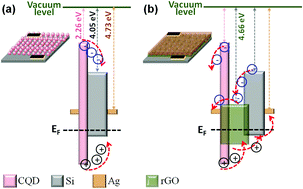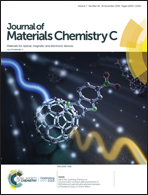Engineering carbon quantum dots for enhancing the broadband photoresponse in a silicon process-line compatible photodetector†
Abstract
Realization of heterojunction based broadband photodetectors (ultraviolet to near-infrared) compatible with existing silicon process technology has great promise for advanced optoelectronic applications. In this report, we demonstrate the application of carbon quantum dots (CQDs) synthesized from organic waste via a facile fabrication technique as a potential broadband photodetector in a hybrid (organic–inorganic) heterostructure with Si. The broadband photoresponse is further improved by impregnating the CQDs with reduced graphene oxide (rGO) and silver nanoparticles (AgNPs). The results show that the optimized incorporation of rGO aids in enhancing the photoresponse due to effective carrier transport, whereas AgNPs intensify the optical absorption due to localized surface plasmon resonance. The maximum responsivity and detectivity for the engineered CQDs are found to be around 1 A W−1 and 2 × 1012 Jones, respectively. This work demonstrates an economic, effective and feasible approach to harness natural resources for technological purposes, which can efficiently be adopted with presently available industry scale technologies.



 Please wait while we load your content...
Please wait while we load your content...